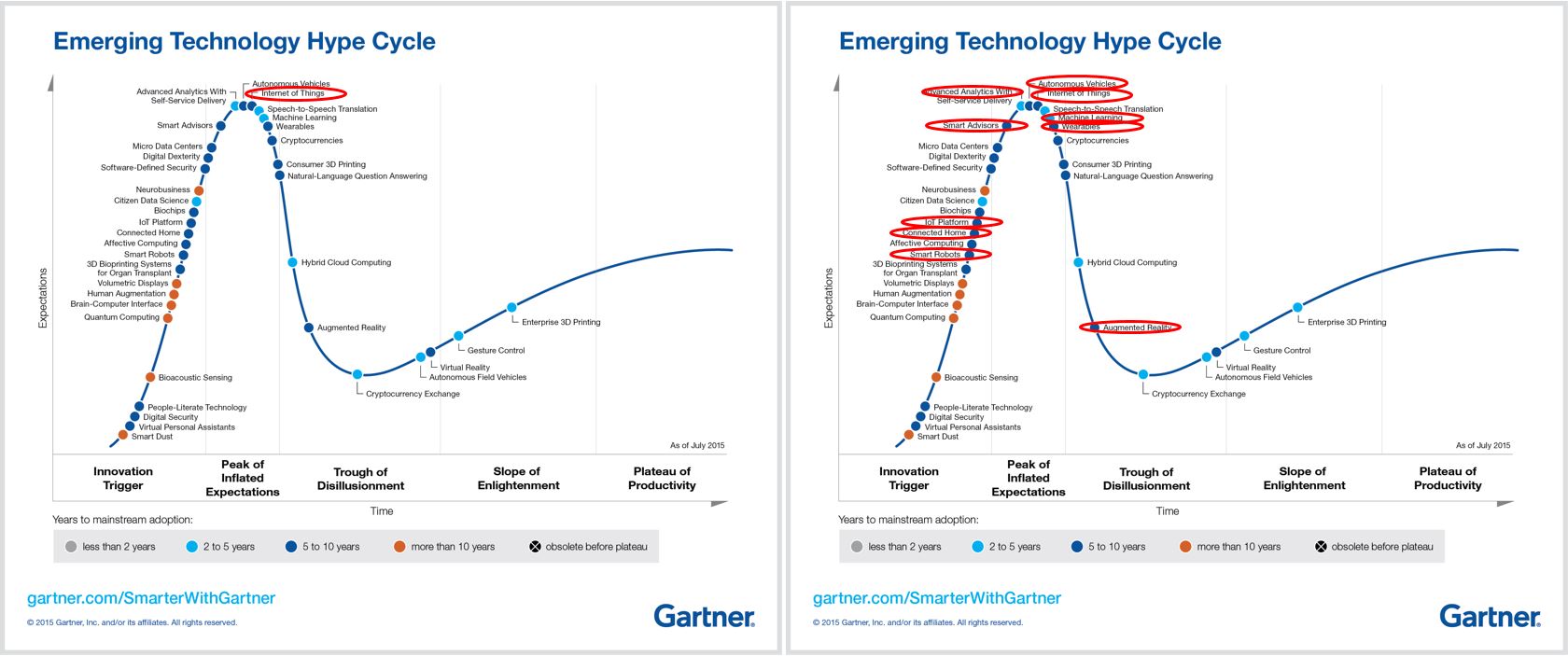Why Gartner is "wrong" and the Internet of things hype won’t drop.
Internet of things, IoT, connected cars, Industry 4.0, Insurance 4.0, smart factories, smart homes, smart cities, smart police, smart banking, smart grid, smart … where will it end? If there’s one thing the Internet of things isn’t short of, it’s names. A sure-fire way to tell that marketing bods the world over have most definitely jumped on the bandwagon of this hot topic. Expectations have reached epic proportions. Technologies and infrastructures are still in their early phases of development. Processes and companies are not yet ready. And if dreams and reality get too far apart, this kind of disillusionment can only set us up for a fall. This is what Gartner describes in its Emerging Technology Hype Cycles, and exactly what the 2015 Hype Cycle predicts for the Internet of things.
This is where Gartner is wrong – and yet right on the money.
The IoT is not simply going to fall into a deep depression. After all, its sheer number of names already goes to show just how many legs it has to stand on. What’s more, all of these ‘legs’ have one thing in common: they describe the real phenomenon that more and more ‘things’ are being kitted out with ever smaller and cheaper sensors and Wi-Fi modules. Just take a look at smartphones, that now include brightness sensors, acoustic sensors, acceleration and gyro sensors, electromagnetic sensors, geomagnetic sensors, infrared proximity sensors, gesture sensors, air pressure sensors, temperature sensors and humidity sensors. And nothing will stop companies from installing these types of sensors in any imaginable object – no matter how big or expensive they might be. This is exactly what large technology leaders are driving forward with no signs of stopping. Take Samsung, for example, which is planning on making virtually all of its devices IoT-compatible by 2017. Whether other companies are now looking to embrace this trend or sit back and watch for the time being is irrelevant; it is most definitely on its way in across all areas of life and business.
This is of course also reflected in the Gartner Hype Cycle. At first glance, the Internet of Things can be found right before the hype bubble bursts. But take a look again and it’s clear that a good third of the listed technology trends are inextricably linked to this phenomenon. Whether it’s autonomous vehicles, connected homes, smart robots, wearables, machine learning or IoT platforms – none of this would even be conceivable without sensor information transmitted via internet protocols.
So what's the learning?
Once companies have recognised and accepted this, it will be time for them to start drawing the right conclusions and getting themselves ready for what’s to come. But the problem for a lot of companies is uncertainty. After all, one of the basic business mantras says if there’s no watertight use case or business case, then there’s no investment. That said, nobody ever really knows which business cases and use cases will ultimately catch on. While it is true that some are destined to remain nothing more than pipe dreams, others spring up out of nowhere and are ready for market in no time at all.
But none of this really matters, as there are more important factors that we do know for certain:
- We know for certain that new data flows and unprecedented volumes of data can be found in old and new business processes alike.
- We know for certain that this data has to be analysed so that it can be transformed into manageable information.
- We know for certain that we’re talking about millions of use cases, big and small.
- We know for certain that conventional project approaches (identifying the problem, creating a project, solving the problem) are too slow and segregated.
- We know for certain that the way we deal with data and analytics is going to have to change.
The conclusion for companies is a simple one: instead of waiting for ‘killer’ use cases like a deer caught in the headlights, the best way forward is simply to get going and make sure their infrastructure is ready to handle the IoT. On an individual level, Internet of things projects are short-lived and quickly become outdated. It is therefore vital for companies to introduce the IoT as a constant process. This requires an analytics infrastructure complete with hands-on, laboratory-style environments in which correlations can be found within data, corresponding models can be developed, and these models can be quickly transferred into operational management. Quite simply, this is the only way for companies to be flexible enough to respond to new use cases and exploit market prospects as quickly as possible.
For more details on the subject, take a look at the e-book Internet of Things: Visualise the Impact or check out my blog ‘Instead of failing fast, how about learning quickly?’


